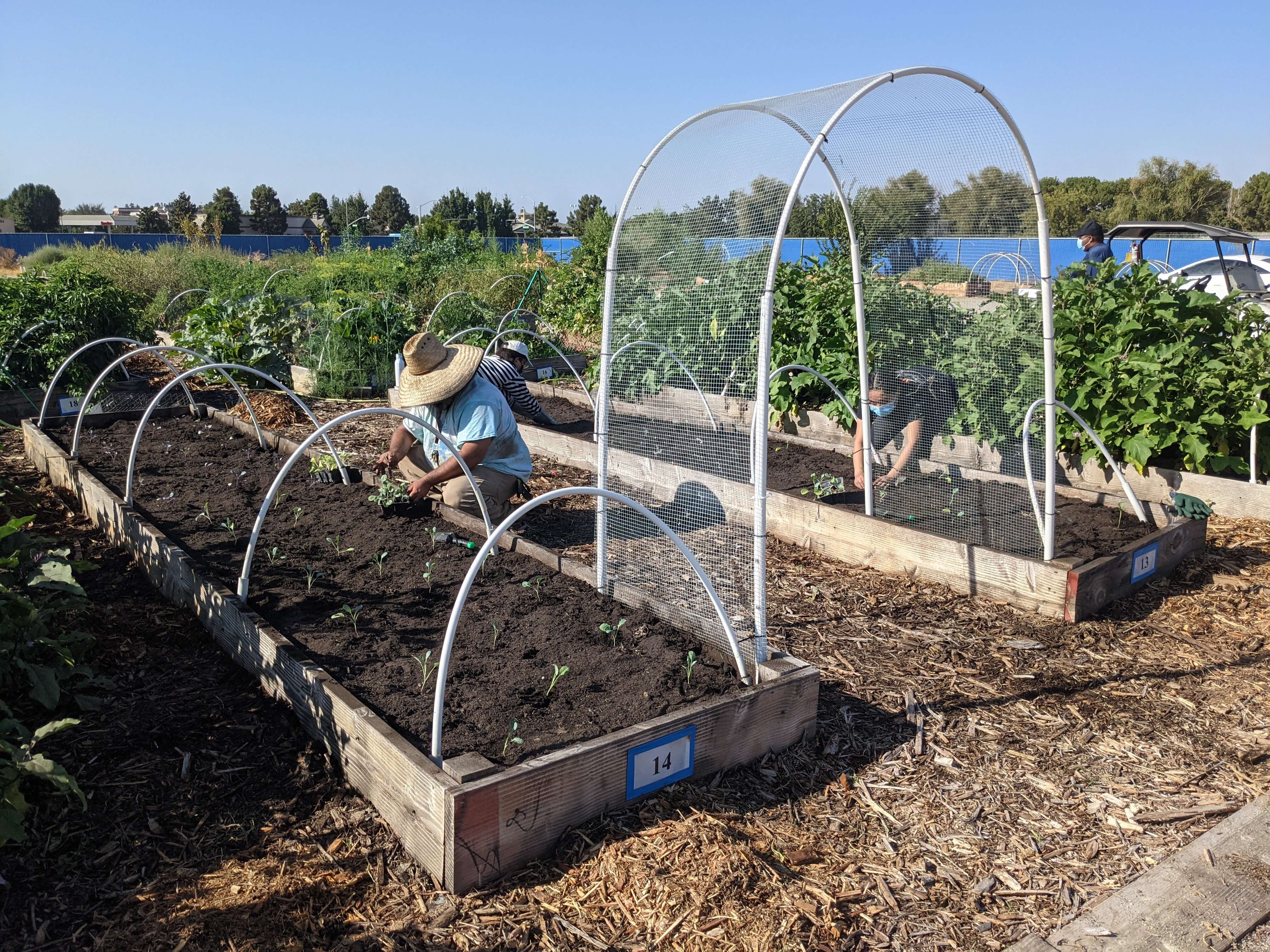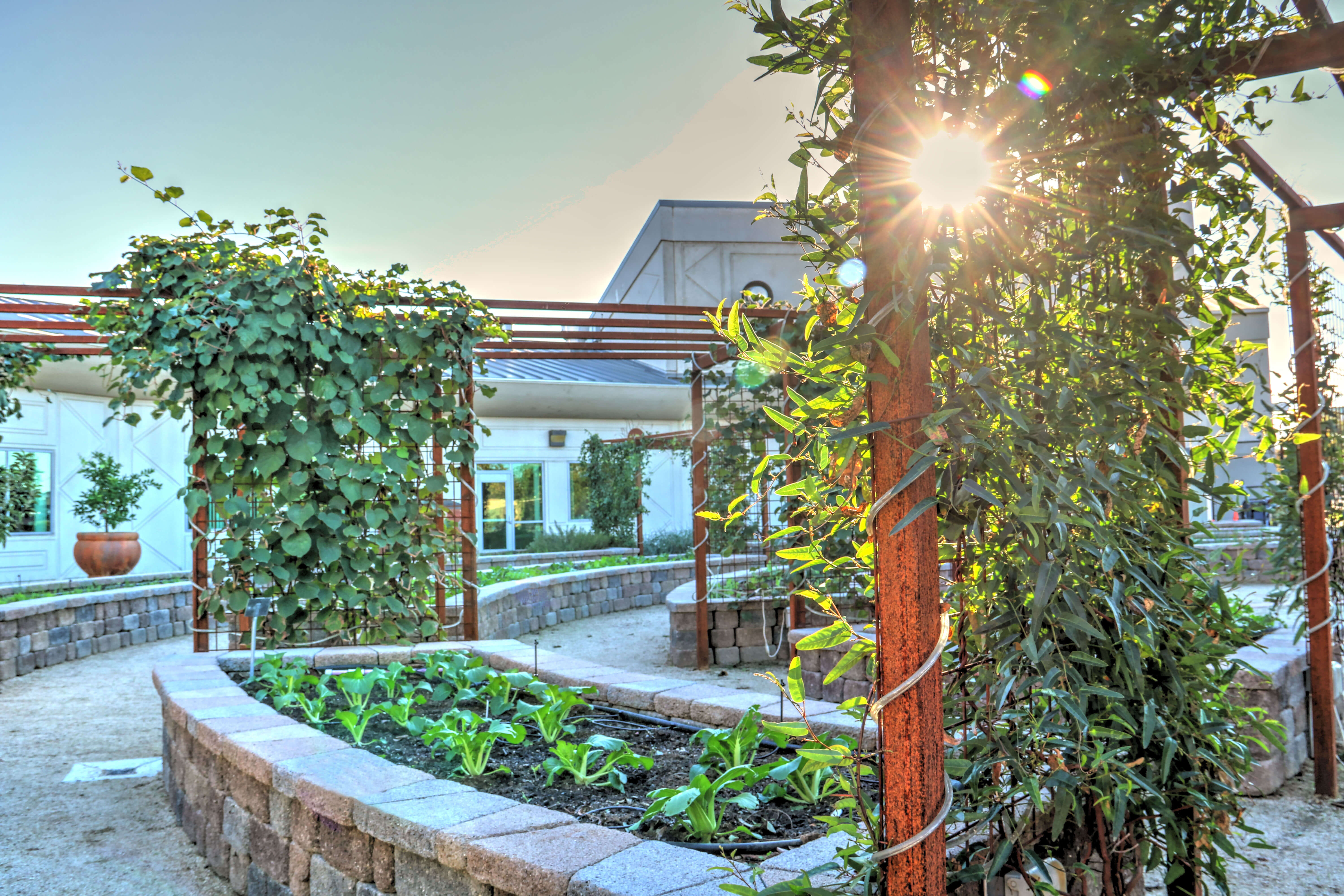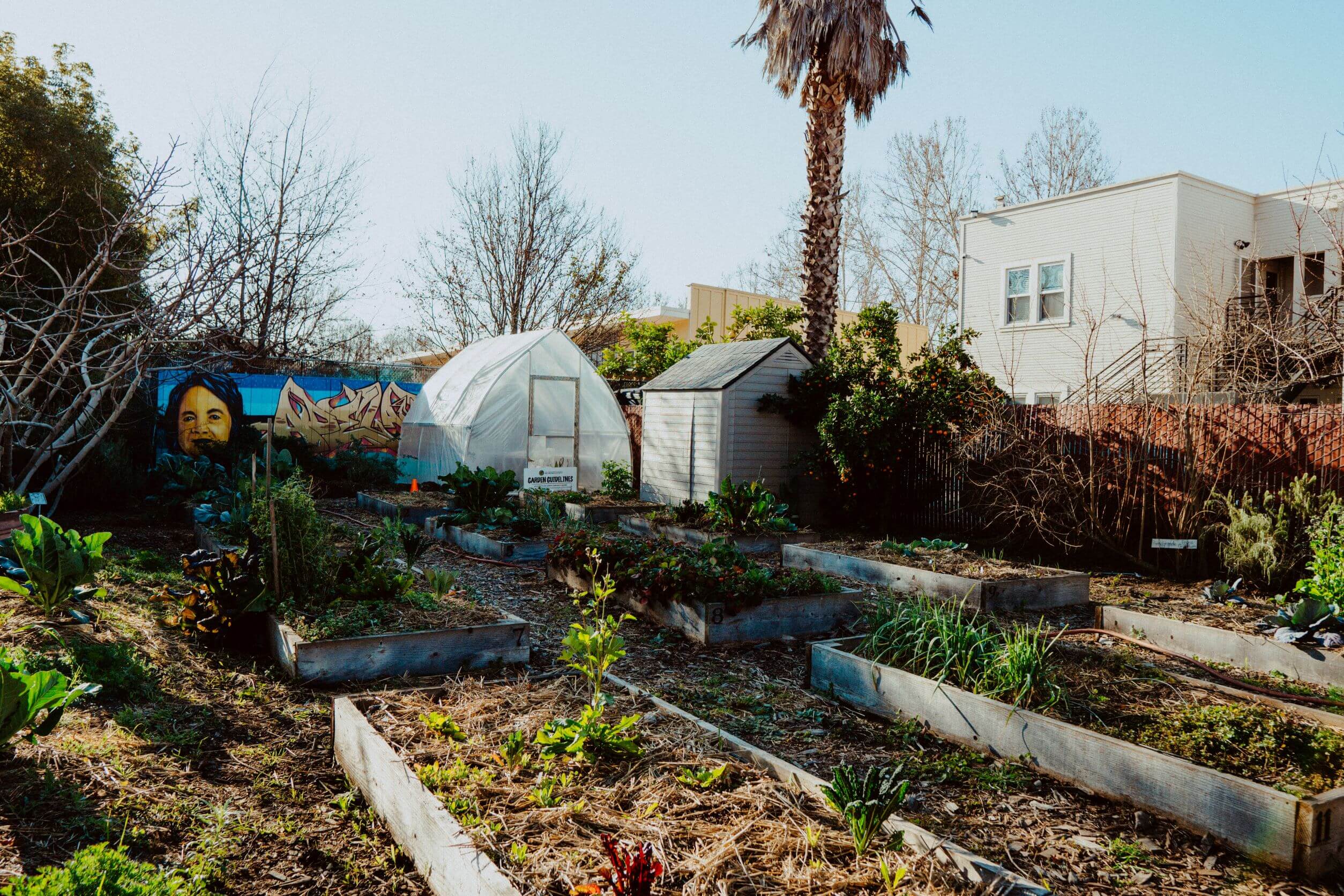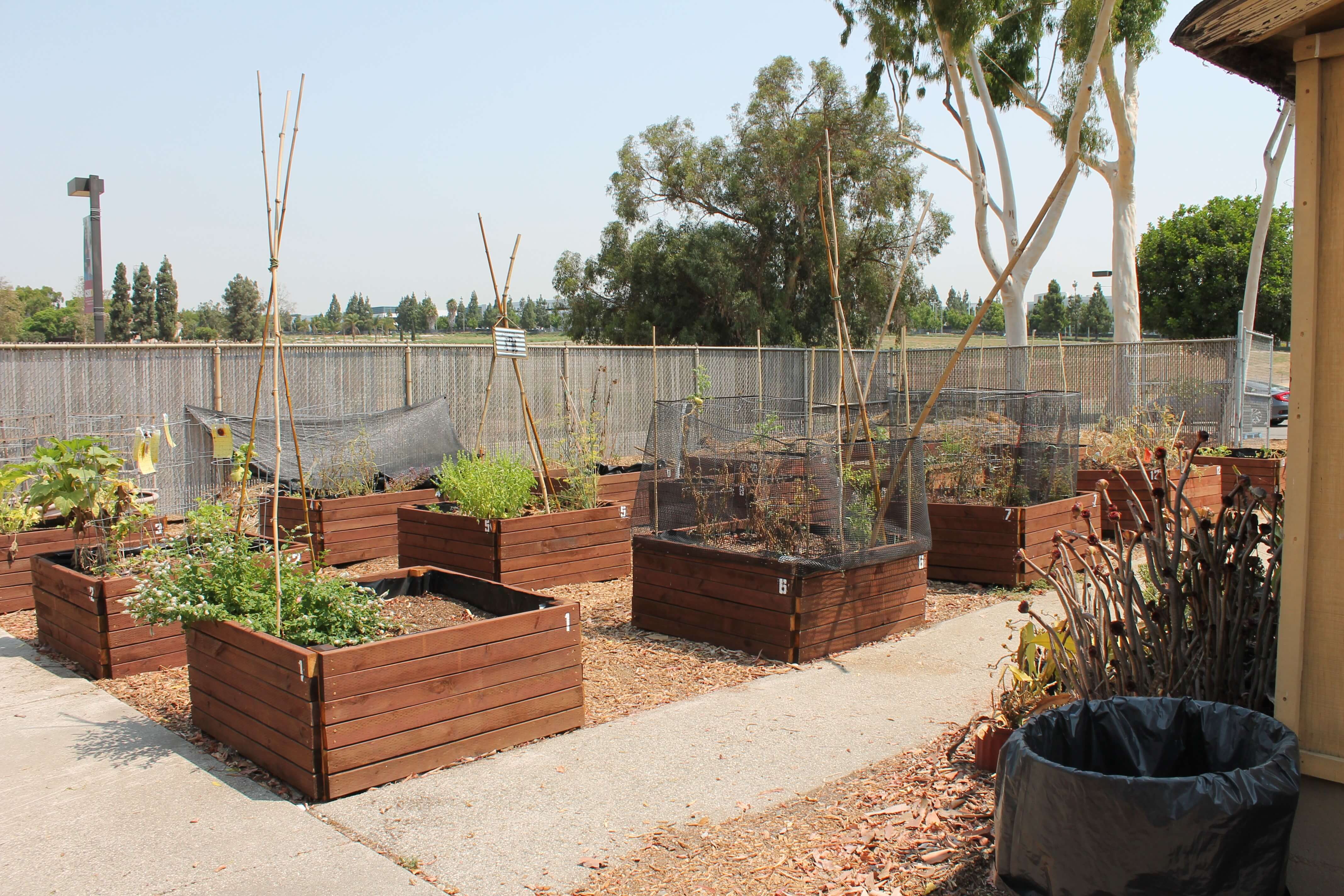From growing bunches of kale on a vertical planter to cultivating a field of corn, campus gardens and farms often perform a key role in their campus communities. Not only do they offer hands-on learning experience for agriculture or horticultural students and foster social connections among student volunteers, but their yields can put food on the table for students in need. See how just a few CSU campuses cultivate these opportunities for growth to address basic needs.
CSU Bakersfield | Planting the Seed

With nearly an acre of raised beds, row crops and a small fruit orchard, the
California State University, Bakersfield edible garden produces thousands of pounds of produce—5,000 in 2021—which is then given for free to CSUB students. The team even aims to double their production this year and
planted more fruit trees in January.
“This speaks to a bigger conversation around food insecurity and basic needs for college students, but healthy food is hard to come by,” says Jason Watkins, Ed.D., director of basic needs. “It's really amazing our students can come and get something that's oftentimes not all that accessible—not to mention what they're getting is fresh produce.”
The produce is harvested and then distributed through a pop-up farm stand on campus, where students can pick up fruits and vegetables without using their food pantry points. The leftovers are given to the students volunteering in the garden and to the campus’s
food pantry. During the COVID-19 pandemic, however, all the produce was donated to the pantry, which then gave it out to students.
One challenge is ensuring students know how to prepare the produce they receive. For this reason, the garden team put together a cookbook in the fall of what to make with the season’s produce and held an online cooking demonstration with the garden’s harvest and cooking essentials from the pantry.
“Kern County is an agricultural production machine, yet some of our outlying communities and even parts of Bakersfield are food deserts and the access to markets and produce is really limited,” Dr. Watkins says. “Students have maybe grown up not having access to those vegetables, and then they get here and now we have a pop-up stand with things people haven't ever seen. That means we need to make sure we are giving them the tools and the skills to know how to prepare the food."
Sacramento State | Beyond the Garden Wall

At
California State University, Sacramento, the
ASI Food Pantry stocks its shelves from myriad means of food production to benefit students. While fruit and almond trees dot the campus, Capital Public Radio is also currently transitioning ownership of the one-acre
CapRadio Garden at Sacramento State to the school. In years past, it has produced upward of 3,500 pounds of food.
“There is a huge need, not only for food, but for healthy food—and that’s what we’re providing through the food pantry, organic produce that we grow right on site,” says Erik Skall, manager of Grounds and Landscaping Services. “Members of the community are also aware of the trees, so throughout the year, you’ll see them come, mainly after hours or on the weekends, and they will harvest for themselves.”
The garden team partners with Kelly Thompson, Ph.D., a professor in the Nutrition, Food & Dietetics Program, and her classes to develop recipes for the seasonal produce. These are posted at the outdoor pop-up pantry or on social media.
“It’s introducing students to what fresh produce is,” says Sustainability Director Ryan Todd. “I’m always surprised that half the time students are not familiar with fresh produce and how to prepare it.”
But efforts also seek to connect the greater community with healthy food options and education, as the team offers tours for local K-12 students that demonstrate how the produce is grown and harvested. “The health aspect has a huge impact, especially for K-12 students and college-aged students seeing how food is actually grown,” Todd says.
San José State | Open Wide the Garden Gate

Started about nine years ago by the Student Hunger Committee to address basic needs, the quarter-acre
Campus Community Garden at
San José State University aims to provide fresh, culturally relevant produce for all students at SJSU.
The majority of the student population is students of color. “Sometimes the produce students have access to does not resonate with their culture,” says Diana Victa, department manager of the
César E. Chávez Community Action Center. “What we've been able to do at the garden is think about the vegetables that look more familiar and connect our students to their cultural food, so growing vegetables like bok choy, cactus and Asian green beans, things that are more culturally relevant.”
The garden also works with Jamie Kubota, a chef and instructor in the Department of Nutrition, Food Science and Packaging, to host cooking demonstrations and ensure students know how to use the produce.
The 3,000 pounds of food grown each year is largely given directly to student volunteers working in the garden. As the focus is on the volunteers, half the garden is undergoing a reconstruction project to implement universal design—such as adding ramps and raising beds to waist height—to ensure all students can volunteer.
“How can we talk about basic needs and environmental justice if there are students who have mobility issues and couldn't access this space?” Victa asks. “It's also not just about mobility. … If you have back issues, if you are pregnant, if you have arthritis, would you be able to work in the garden? That's what we mean by universal design; it is the access to work at the garden no matter what your ability is.”
Finally, the garden has grown its partnership with the
Spartan Food Pantry to reduce waste on campus. Leftover produce is donated to the pantry to be distributed to students, and the pantry gives its food waste to the garden to be used as compost.
CSU Dominguez Hills | Small But Mighty

While only about .11 acres with 15 small raised beds, the
Campus Urban Farm at
California State University, Dominguez Hills is a productive source of fresh produce for the campus, thanks to innovative growing methods like vertical planters and hydroponic towers.
“That's really in line with the whole concept of urban gardening, because we're trying to educate students who don't have access to open fields and acres of land,” says Sustainability Manager Ellie Perry. “These are actually very in line with a farming style appropriate for city living.”
The produce is given out to students at the
Toro Food Pantry’s distribution events, held monthly, or donated to partners like University Housing and student affinity centers. The sustainability and basic needs teams also work closely with a farmers’ market to bring even more produce to campus, given the area around CSUDH is a food desert and campus housing doesn’t have dining halls. These combined efforts won the team a
statewide best practice award in Sustainable Food Service at the 2020 California Higher Education Sustainability Conference.
“Our main goal was to provide as much food as possible because we don't necessarily know what students’ households look like,” says Basic Needs Coordinator Morgan Kirk. “We want to make sure the food we're providing is not only nutritious but lasts longer.”
During COVID-19, the pantry switched to handing out bags of food in the parking lot once a month. Because of the student assistant team and volunteers from the Osher Lifelong Learning Institute, the garden continued to flourish and provide produce to include in the bags.
Like other campuses, CSUDH is also providing cooking education, held online during the pandemic and now offered in person in the residence halls. “In partnership with CalFresh and Basic Needs, we're all showing people how to cook fresh produce and eat healthy on a budget,” Perry says.
FOOD FOR THOUGHT
These four campuses are only a sampling of the cultivation happening across the CSU. Below, explore more gardens and farms on our campuses—some of which have an established relationship with basic needs, some that focus on student learning or connection and others that are still starting up.